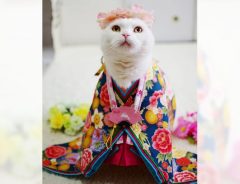
Source: 掬茶, CC BY-SA 4.0, via Wikimedia Commons
‘Watch out, he bites’: Japan’s dogs before the ‘pet boom’
Related Article
-

Pets Celebrate Girl’s Day In Japan And Look Better Than All Of Us
-

Fed Up Little Shiba Inu Adorably Snaps Back At Her Parent
-

Japan’s problem with puppy farms, plus where to adopt a pet in Japan
-

Wasabi The Dog Celebrates His 10th Year As Japan’s First-Ever Shiba Inu Ball Boy
-

The Way This Shiba Begs For Attention Is Way Too Cute!
-

Coca-Cola celebrates 3 festivals from northern Japan in one gorgeous design sold exclusively in Tohoku


Japan is the only country in the world in which pets outnumber children. The country has just 17 million children under the age of 16, yet almost 20 million cats and dogs.1
This is quite a turnaround, for until recently pet ownership was a foreign novelty. Perhaps as a result, most dogs in Japan are foreign breeds, like poodles, chihuahuas and dachshunds.
However, there are six native breeds in Japan. The most popular are the Shiba and the Akita (Hachiko, the most famous dog in Japan, was an Akita). Less well known are the Kishu, Shikoku, Hokkaido, and Kai.
This standard was determined in 1934 by the 日本犬保存会 nihon-ken hozonkai, a public organization responsible for preserving and maintaining registries of Japan’s six native breeds of dog.
Shibas are the most popular breed of dog in Japan. | 森平 爽一郎, CC BY-SA 4.0, via Wikimedia Commons
Frankly, to a foreign eye, the six native breeds look remarkably alike, which is not surprising when you consider how little interaction Japan and its dogs had with the outside world until modern times.
It is generally believed that the six native breeds are descended from dogs brought to the Japanese archipelago 10-12,000 years ago by the Jomon people, the earliest-known migrants to Japan.
Until modern times, most Japanese dogs had a utilitarian purpose, mainly hunting wild boar in remote mountainous regions. Hunting is at the root of the relationship between humans and canines. Around 20,000 years ago, humans developed a symbiotic relationship with wolves for their mutual benefit. Wolves protected human residences from nocturnal predators and cooperated when humans went hunting other wild animals. Between 15,000 and 20,000 years ago, wolves became tame and evolved into dogs.
This Kishu is just seven months old. | CJ Hammond, CC BY-SA 4.0, via Wikimedia Commons
So for most of their history, Japanese dogs have been hunting companions, not pets. Far from being members of the family, most of them were strays, who did not belong to anyone in particular and were regarded as residents of the community. Traditionally, Buddhist dogma holds that dogs are unclean. These strays were fed on leftovers, and the very idea that you might bring them into the family home would have been unthinkable.
However, plenty of villagers felt affection for dogs. Indeed, they admired them for their spiritual qualities. Dogs were believed to be able to travel freely between the here-and-now and the afterworld and were even thought to possess the power to wreak spiritual vengeance on people.
A Shikoku dog. | chrisguyhere, Public domain, via Wikimedia Commons
That’s why special procedures were required to ensure protection from the spirits of dead dogs, such as burial in specific locations, and the inclusion of specific items in their graves.
Japan’s oldest dog grave is a burial mound in Kishiwada, Osaka. It marks the final resting place of a famously faithful dog that is said to have lived in the sixth century.
According to tradition, among the retainers of Mononobe no Moriya, who fought against the Soga to oppose the introduction of Buddhism to Japan, was a man named Toritoribe no Yorozu.
When his lord was killed in battle, Yorozu took his own life. His faithful dog Shiro rescued Yorozu’s head from the scene and buried it. Shiro then kept constant guard over his master’s grave until he died of starvation.
When the imperial authorities heard about the fidelity and devotion of Yorozu’s dog, they felt deeply moved and allowed a grave to be built for Shiro next to his master.
To this day, members of the Tsukamoto family, who believe themselves to be Yorozu’s descendants, gather at the graves of Yorozu and his faithful hound every autumn to mark the anniversary of their deaths. Amazingly, these Buddhist memorial services have continued without interruption for nearly 1,500 years.
The story of Yorozu and Shiro goes to show that while mass pet ownership might be a recent novelty in Japan, dogs have been admired for their loyalty for centuries. And in accompanying its owner into the afterlife, the story also hints at why dogs have become so popular in an age of mass childlessness.
______
Notes:
1 "Cats outnumber dogs as pets in Japan for second straight year" (Japan Times, Dec. 26th, 2018)